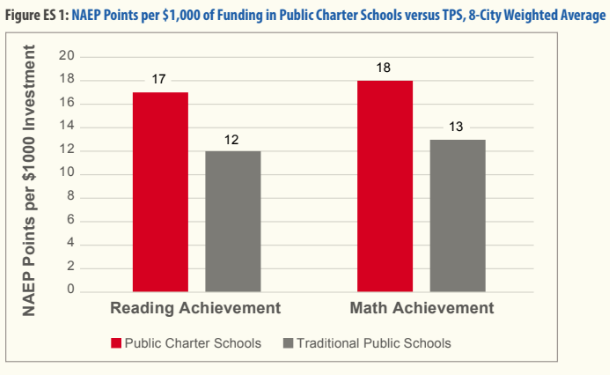Analysis: Charter Schools Yield 53% Greater Return on Investment Than Traditional Public Schools

Charter schools are the object of intense national debate. They shouldn’t be. The data show that public charters are a good investment.
In five studies that we’ve conducted during the past several years, we’ve compared traditional schools and charter schools in a diverse roster of U.S. cities where a substantial portion of families are choosing charters. We’ve examined how much funding each sector receives and how much learning each produces. The facts are quite clear:
Charter schools do more with less.
Our first report, “Charter School Funding: Inequity in the City,” identified a significant funding gap between traditional and chartered public schools. In 14 cities spanning the country, from the nation’s capital to Memphis to Los Angeles, charter schools received considerably less funding — an average of $5,721 per pupil — than traditional schools. To put it another way, families sacrificed about one-third of their educational resources when they chose to enroll in charter schools.

Two years later we revisited these same 14 cities and found that the funding gap between traditional and charter schools had increased slightly, to an average of $5,828 per pupil. Local funding sources, including property and sales taxes, were the biggest contributors to the disparity. (A third report that focused on New York City’s charter and traditional schools yielded similar findings.)
At the same time, we wanted to factor in academic achievement. In 2018 we completed a study measuring the cost-effectiveness — the amount of learning per educational dollars spent — of charter and traditional schools. To determine academic performance, we used results from the National Assessment of Educational Progress and the Center for Research on Education Outcomes at Stanford University.
For that study, we focused on eight cities that, despite their different sizes and demographics, all have substantial charter sectors: Atlanta, Boston, Denver, Houston, Indianapolis, New York City, San Antonio, and Washington, D.C. In each city, we found that charter schools were more academically cost-effective than traditional schools.

We found that charter schools continued to demonstrate greater value than traditional schools in a follow-up report released earlier this month. “A Good Investment: The Updated Productivity of Public Charter Schools in Eight U.S. Cities” reports that in reading, charter schools averaged 4.80 points higher — per $1,000 funded — than traditional schools, making charters 40 percent more cost-effective in reading. In math, charters average 5.13 points higher per $1,000 funded, making them 40 percent more cost-effective in math.
We also measured the taxpayer return-on-investment generated by each sector. Our most recent report found that charters’ ROI exceeds that of traditional public schools by an average of 53 percent over the course of a 13-year investment in a K-12 education.

While our research demonstrates that charters do more with less, it also brings up the question: Should charters get stuck with less funding in the first place?
Presuming that policymakers believe in the principle of equity, they should fix the funding structures that currently grant substantially fewer resources to charter schools. They should allocate education dollars in a way that ensures a given public school student receives the same amount of resources whether they choose to enroll in a charter or traditional school.
To boost academic performance across the public education system, policymakers should examine why charter schools, despite receiving less funding, yield greater academic achievement than traditional schools. What are charters doing differently? Several researchers, including Philip Gleason of Mathematica Policy Research and Mark Berends of the University of Notre Dame, as well as report co-author Patrick Wolf, have conducted initial studies of charter school best practices. That vital line of research should be broadened and deepened.
What makes Washington, D.C., charters 43 percent more cost-effective than the city’s traditional schools, and why do charters there produce a 58 percent higher ROI than traditional schools? Why are charter schools in New York City 26 percent more cost-effective — with a 53 percent higher ROI — than nearby traditional schools?
In light of the evidence, these are the questions that policymakers should ask. The sooner policymakers can answer them, the sooner they can figure out how charter schools can best achieve one of their original promises — to stimulate improvements in all public schools.
Corey A. DeAngelis is an education policy analyst at the Cato Institute. Patrick J. Wolf is Distinguished Professor of Education Policy and 21st Century Endowed Chair in School Choice at the University of Arkansas in Fayetteville. Larry D. Maloney is president of Aspire Consulting, LLC. Jay F. May is founder of, and senior consultant for, EduAnalytics, LLC.
Get stories like these delivered straight to your inbox. Sign up for The 74 Newsletter

;)
